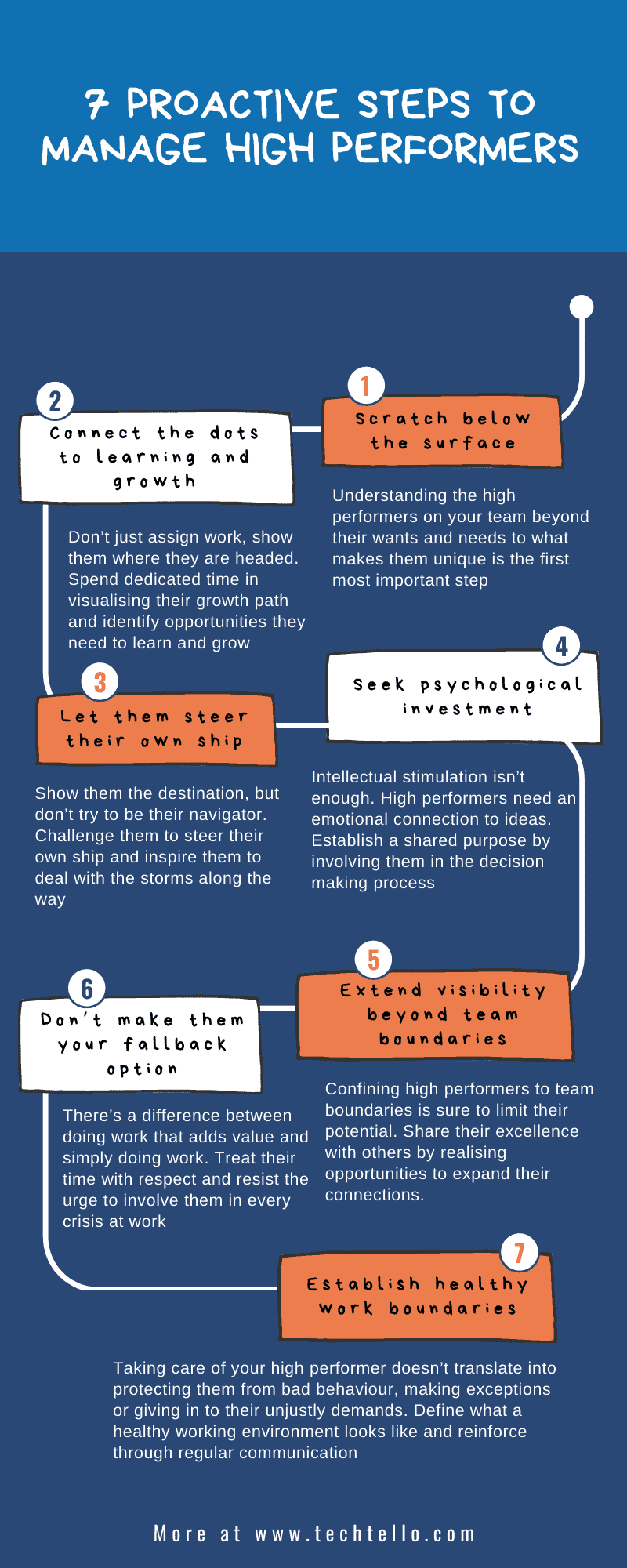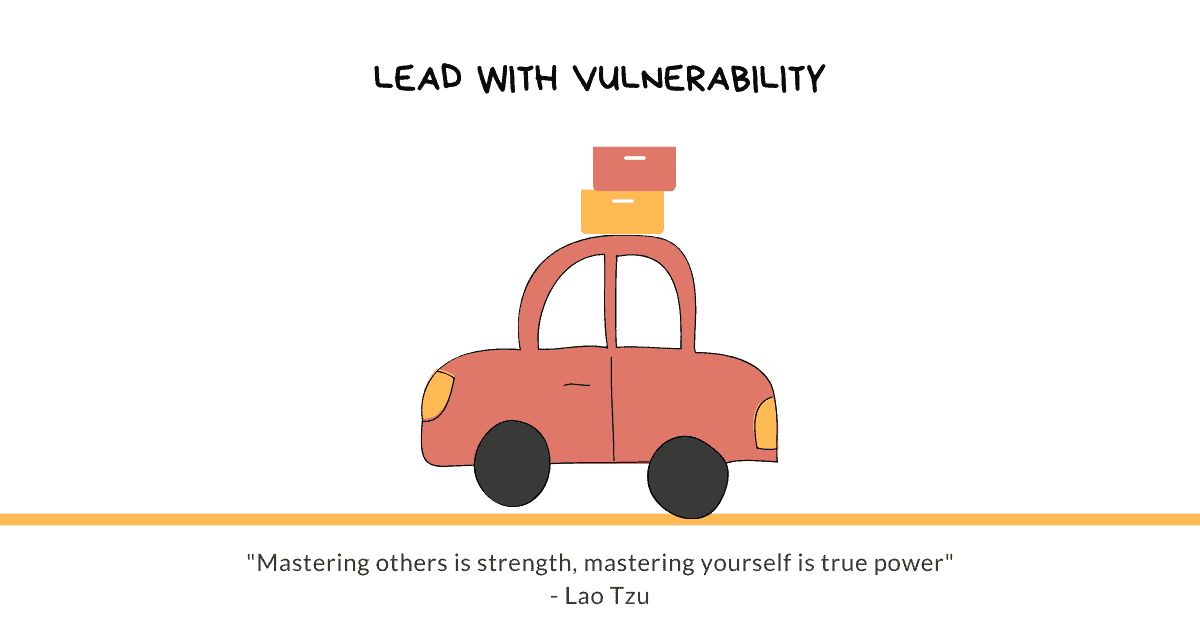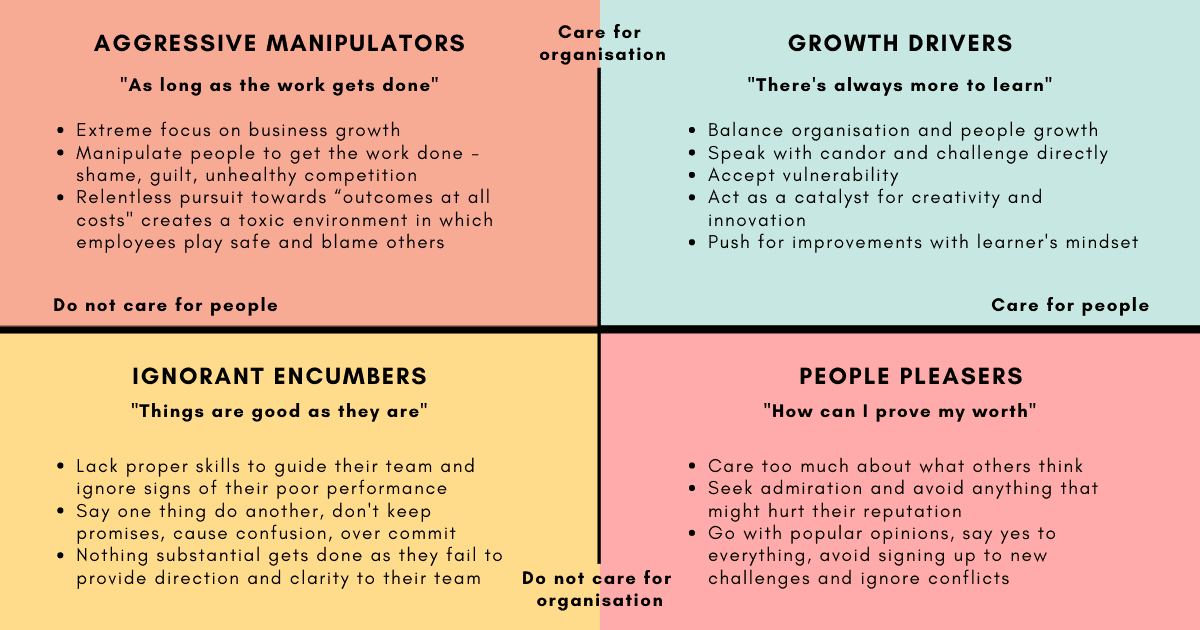High Performers: 7 Proactive Steps To Lead Them To Excellence

High performers in any organisation aren’t easy to manage. With their uncanny ability to produce outstanding work and an appetite to solve tough problems, they demand even greater attention and engagement from their managers.
And these managers are so busy putting out fires, attending meetings, convincing stakeholders and solving for poor performance that they fail to prioritise the one thing that deserves their time and energy – their top performers.
With an excuse of a busy schedule, they fool themselves into believing that their high performers are already doing great and invested to excel in their role which is sufficient to keep them inspired and committed to the job.
Without taking time to form a deeper connection with their high performers and investing in personalising their experience, they put them into the same bucket as everyone else. High performers aren’t cut out for a normal growth path and the moment they sense a discrepancy between their journey and the direction in which their growth is headed, they lose interest in their work and start looking out.
What they leave behind is a shocked, clueless manager who cannot fathom their decision – what went wrong, how did they miss the signs and what they could have done to avoid this outcome?
“Talent is the multiplier. The more energy and attention you invest in it, the greater the yield. The time you spend with your best is, quite simply, your most productive time”, says Marcus Buckingham in First, Break All the Rules.
This is so true. A high performer is 400% more productive than an average performer. Losing them robs the organisation of excellence while also incurring additional cost, time and effort to hire their replacement.
As a manager, you need to care enough to not lose your high performers. Nothing will be more valuable than the time invested in helping your excellent performers achieve further excellence. Some questions to trigger the thought process:
- Do you know their goals? How are the challenges and growth opportunities aligned with those goals
- How are you creating a path to maximise their strengths while helping them grow in their responsibilities
- Are you making sure they are not being pushed to edge and experience burnout as a result
- How do they prefer to be appreciated and recognised for their contribution
- Do you actually listen to their suggestions and make an effort to incorporate their feedback
- Do they have a coach (either you or another person) who’s invested in helping them get better at their job
- How do you measure if they are satisfied or unsatisfied with their outcomes
- What kind of growth path do they seek – management or individual contribution
- What are early warning signs to sense disengagement
- Are they being paid exceptionally well or do they have a reason to seek other opportunities that will pay them what they deserve
- How flexible are you to accommodate their work preferences
- Do you enable them to contribute to a shared purpose
- What visibility do they need beyond their team and how do you create that visibility
The good and the bad of working with high performers

High performers show a strong inclination towards challenging projects, demonstrate the ability to push forward despite difficult circumstances and drive outcomes for the organisation. They are the default choice for leading key projects, pulled in at critical moments when another project is on fire and expected to step in to resolve urgent issues that impact business.
Done right it can be a rewarding experience for the team who can lean on high performers to learn and grow. They can also be a source of motivation and the drive to achieve excellence in the team. Their mindset plays a huge role in determining whether they choose to work alongside others or expect others to follow their lead.
Some high performers aren’t necessarily easy to get along types and exhibit behaviours that annoy others – getting agitated when people make mistakes, expecting them to work at their pace, finding it hard to understand what’s simple to them is difficult for others, pushing extremely hard without stopping and even belittling others when things don’t work out.
They may also impose their viewpoint with the belief that they are always right, consider disagreement as an attack on their identity and leave less opportunities for others in the team by trying to be at the forefront of all major projects.
Some go as far as feeling entitled to special treatment – not coming to meetings on time, ignoring processes, taking off without informing anyone and doing only work that they like.
“Sometimes really talented people have heard for so long how great they are, they begin to feel they really are better than everybody else. They might smirk at ideas they find unintelligent, roll their eyes when people are inarticulate, and insult those they feel are less gifted than they are. In other words, these people are jerks. Many may think, “This guy is so brilliant, we can’t afford to lose him.” But it doesn’t matter how brilliant your jerk is. The cost of jerkiness to effective teamwork is too high. Jerks are likely to rip your organization apart from the inside”, says Reed Hastings in No Rules Rules.
Left unattended, they can do more damage than good to their teams and can be a major source of fear, resentment, toxic behaviour and envy in the team. A manager who’s not careful to handle these behaviours will be perceived as biased, subjected to criticism for favoring the high performer and eventually lose trust with their team members.
Establishing a healthy boundary of acceptable and unacceptable behaviour is critical to provide a work environment in which all team members can thrive.
7 proactive steps to manage high performers
1. Scratch below the surface
Understanding the high performers on your team beyond their wants and needs to what makes them unique is the first most important step. Get behind those closed doors, take a peek inside and try to see the world as they see it.
They won’t let you in at the first instance, but with a genuine curiosity to be a part of their journey, you can get access to their personal map.
- What are their principles and values
- What keeps them up at night
- What do they really care about
- What kind of challenges do they seek in their work
- How do they like to be recognised
- What are their expectations from you as a manager and others on the team
- How do they like to receive feedback
- What’s unacceptable and a deal breaker for them
- How do they like to communicate
You are not expected to please them, give in to all their demands or adjust your ways to their ways of doing things, but having access to this information provides a strong foundation for future conversations to align on mutually acceptable ways of working together as a team.
2. Connect the dots to learning and growth
Top performers don’t just like to stay busy. They want to do impactful work, derive a sense of accomplishment from solving tough problems and constantly seek to push the boundaries of their own limits.
They strongly align with what Daniel Pink said in Drive “Greatness and nearsightedness are incompatible. Meaningful achievement depends on lifting one’s sights and pushing toward the horizon.” Their passion for their work and confidence in pulling off challenging projects keeps them hungry and desperate for more.
Don’t just assign work, show them where they are headed.
Spend dedicated time in visualising their growth path, identify the opportunities they will need along the way and ensure their work is aligned with the challenges they need to learn and grow. Don’t hesitate to look beyond the boundaries of your team to other areas that might be better suited for their growth.
Remember, charting out this path is not the end of your responsibility, it’s the beginning of one. Companies evolve and so do people in it. Keep an eye out for a change in market conditions, their own personal preferences or anything else that may require you to revisit this plan.
Miss a few dots along the way and you are sure to lose your high performer.
3. Let them steer their own ship
High performers don’t just appreciate good work, they find pleasure in carving out their own path. Facing the ups and downs, tackling challenges along the way, dealing with failures and setbacks and finding ways to get past them is what inspires them.
Show them the destination, but don’t try to be their navigator. Challenge them to steer their own ship and inspire them to deal with the storms along the way. Let them experiment, try different ideas and put new strategies in place to get the outcomes you both desire.
By providing them with a sense of autonomy with clarity of purpose and putting trust in their abilities, you will empower them to make the right decisions along the way. Even if they make mistakes, know that they will pour all their energy into setting things right.
Focus on your destination, but know there’s no single path to reach it. Consider working with a high performer as an excellent opportunity to break mental barriers and embracing new ways of doing things. There’s so much to learn only if we keep our ego aside and approach them with an open mindset.
4. Seek psychological investment
Intellectual stimulation isn’t enough. High performers need an emotional connection to ideas. If they don’t buy into an idea, they won’t pour all their energy into making it successful.
It’s not about seeking their consensus on every strategy and tactics, but rather aligning on a shared purpose. Involve them in the strategic planning phase, seek their ideas, do not avoid confrontation and indulge in healthy disagreements.
By being part of the context and rationale that goes into decision making, they will learn to focus on the right things. Instead of only worrying about efficiency that deals with “what and how”, they will think about the value in being effective first, which will require them to question the “why”.
This will also help them broaden their sense of right vs wrong and shift from me vs them to doing work that’s in the larger interest of the organisation. They will learn to say no to requests that do not align with their goals, communicate effectively with clarity of purpose and build other essential skills required to grow in their role.
Being the creator of their own path will make them psychologically invest and commit to excellence.
5. Extend visibility beyond team boundaries
Confining high performers to team boundaries is sure to limit their potential. Others cannot utilise their expertise and knowledge if they don’t even know of their existence.
Help them grow their network in the organisation and connect to people from different teams and functions by creating opportunities to share knowledge with others. Ask them to lead discussions with other teams, present ideas to leadership, participate in talks and conduct learning sessions.
An important element before creating visibility is to take their personality into account. Some introverts are not comfortable in speaking to large groups but do great with small groups of people. They may also need preparation time to speak about their ideas in a meeting. So, instead of relying on spontaneity, give them up a heads up that you will be asking about their opinion in a meeting. Small adaptations like these go a long way in putting their strengths to use and build the comfort level required to communicate effectively with others.
“Introverts need to trust their gut and share their ideas as powerfully as they can. This does not mean aping extroverts; ideas can be shared quietly, they can be communicated in writing, they can be packaged into highly produced lectures, they can be advanced by allies. The trick for introverts is to honor their own styles instead of allowing themselves to be swept up by prevailing norms”, says Susan Cain in Quiet.
Discuss the importance of visibility, take their personal preferences into account, help in removing the communication hurdles and design the right kind of environment to get them the right kind of visibility. Don’t make them hate it by pushing them into doing it your way. These negative emotions will be sufficient to drive them away from the organisation.
6. Don’t make them your fallback option
High performers love to contribute. But, there’s a difference between doing work that adds value and simply doing work.
High performers tend to become the default option for every crisis in the team – an urgent issue that needs to be resolved, tasks on a project that’s running behind schedule, picking up slack from a non-performing team member.
Instead of getting quiet time to do focussed work, they are constantly distracted by meetings, other team members who demand their attention and work that does not align with their goals. By spending a large amount of their time solving other people’s problems, they have less time left to do their own work. This makes them stretch and work into long hours to get their own work done.
Sooner or later, frustration creeps in, long working hours impacts their health and well being and can even be a source of their burnout. Instead of creating impact through their ability to produce high quality work, they stop adding value.
Helping your high performers manage their time well will be the most important investment of your own time.
Ensure fair distribution of work, set up expectations on work allocation and responsibilities, motivate others to step up in their role and stop using your high performer as your fallback option.
7. Establish healthy work boundaries
“For an individual to be deemed excellent she can’t just be amazing at the game; she has to be selfless and put the team before her own ego. She has to know when to pass the ball, how to help her teammates thrive, and recognize that the only way to win is for the team to win together”, says Reed Hastings in No Rules Rules.
Taking care of your high performer doesn’t translate into protecting them from bad behaviour, making exceptions or giving in to their unjustly demands. That would be irresponsible behaviour. Yes, they could be paid exceptionally high compared to others based on the value that they produce for the organisation. In no way, it gives them the license to mistreat others or expect blind obedience to their way of doing things.
Establish healthy boundaries with the high performers in your team – reinforce good behaviour and confront bad ones, discuss ideas on how to achieve excellence as a team and not just individual goals, coach them to respect others ideas and opinions without necessarily agreeing to their viewpoint and most importantly define what good team communication looks like.
Summary:
High performers are keepers, don’t lose them. They demand your time and attention more than others. Lead your high performers towards excellence and not away from it by:
- Scratch below the surface: Go beyond wants and needs to what makes them unique. Learn about their strengths
- Connect the dots to learning and growth: Identify the opportunities and ensure their work is aligned with the challenges they need to learn and grow
- Let them steer their own ship: Show them the destination but let them be the creator of their own path
- Seek psychological investment: Establish a shared purpose and seek emotional connection by involving them in the decision making process
- Extend visibility beyond team boundaries: Share their excellence with others by realising opportunities to expand their connections, don’t limit it
- Don’t make them your fallback option: Treat their time with respect and resist the urge to involve them in every crisis at work
- Establish healthy work boundaries: Define what a healthy working environment looks like and reinforce through regular communication






























